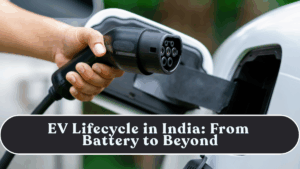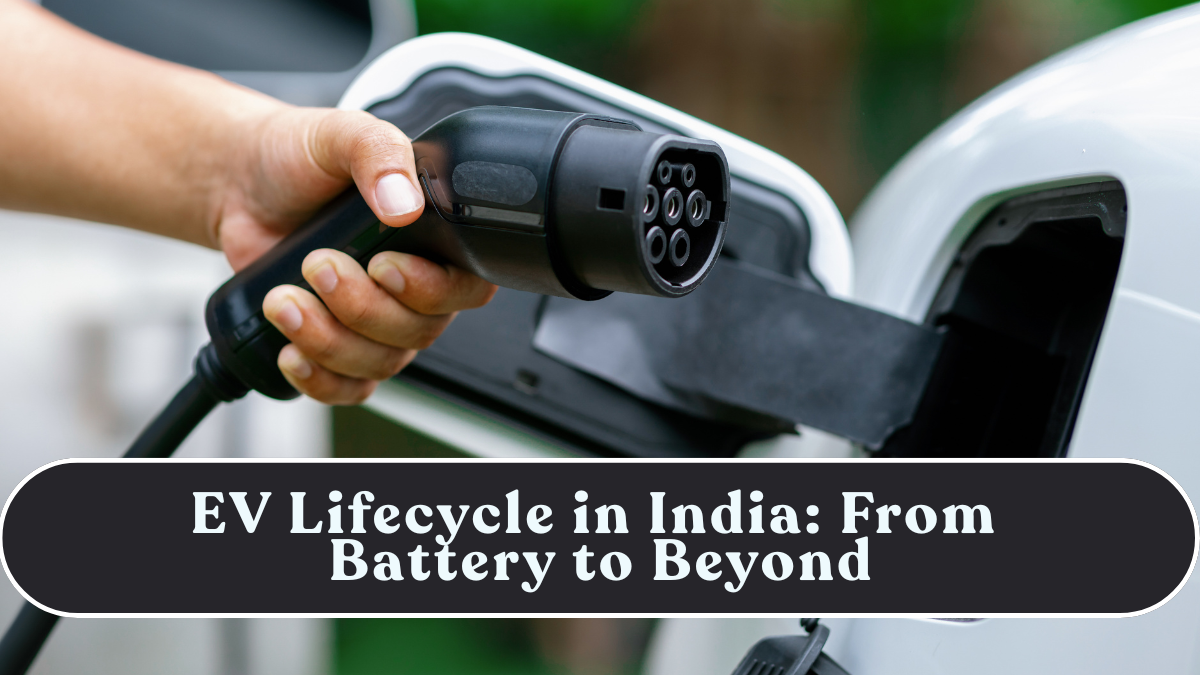India’s electric vehicle (EV) revolution is picking up pace, with millions of two-wheelers, cars, and buses transitioning toward clean mobility. But as adoption rises, one critical question comes into focus — what happens to an EV after its first life? Understanding the EV lifecycle — from raw material sourcing to battery recycling — is essential for sustainability, policy planning, and long-term cost efficiency.

1. The Beginning: Manufacturing & Raw Materials
The EV journey begins in the factory, but the story starts much earlier — in mines and material sourcing.
-
Lithium, nickel, cobalt, and manganese are core elements of EV batteries, most of which are imported from Australia, Chile, and Indonesia.
-
India currently imports over 80% of its battery cells, though domestic production is expanding under the PLI (Production Linked Incentive) scheme.
-
Manufacturing EVs emits fewer pollutants over their lifetime than ICE vehicles, but initial carbon footprint is higher due to battery production.
The push for localized battery production in Gujarat and Tamil Nadu aims to cut emissions and boost self-reliance.
2. The Use Phase: Efficiency & Maintenance
Once an EV hits the road, its lifecycle advantages over petrol and diesel vehicles become clear.
-
Zero tailpipe emissions drastically reduce urban air pollution.
-
Energy efficiency: EVs convert 85–90% of electrical energy to motion, compared to 30–40% in ICE vehicles.
-
Low maintenance: Fewer moving parts mean fewer breakdowns and reduced servicing costs.
-
Battery health monitoring via connected systems extends operational life.
The average EV battery in India lasts 8–10 years depending on usage, charging habits, and climate conditions.
3. The Mid-Life: Battery Replacement and Reuse
Battery degradation doesn’t mean end-of-life — it marks a transition.
-
After dropping below 70–80% capacity, batteries are repurposed for stationary energy storage (solar power, telecom towers, etc.).
-
Startups like Lohum Cleantech and Attero Recycling specialize in battery second-life applications, creating a circular energy economy.
-
Government incentives are being designed to encourage manufacturers to take back used batteries for repurposing or recycling.
This stage is vital for India’s sustainability goals — extending each battery’s utility helps reduce import dependency and waste.
4. The End of Life: Recycling and Resource Recovery
When an EV or its battery can no longer function, recycling becomes critical.
Recycling helps recover valuable materials like:
-
Lithium and nickel (up to 90%)
-
Cobalt and copper (up to 95%)
-
Graphite and aluminum (70–80%)
These recovered materials are then reintroduced into the manufacturing cycle. India currently has over 25 authorized battery recyclers, and this number is rapidly increasing.
Government regulations such as the Battery Waste Management Rules 2022 make manufacturers responsible for the safe disposal and recycling of batteries — a crucial step toward circular sustainability.
5. Environmental Impact Across the Lifecycle
| Lifecycle Stage | Environmental Impact | Sustainability Mitigation |
|---|---|---|
| Manufacturing | High energy use, mining impact | Local battery production, green factories |
| Use Phase | Zero emissions, energy efficiency | Renewable electricity for charging |
| End of Life | Potential waste, heavy metals | Advanced recycling and reuse programs |
While manufacturing remains energy-intensive, the total lifetime emissions of an EV are 50–60% lower than those of a fossil-fuel vehicle.
6. Policy Push and Industry Collaboration
The Indian government has recognized lifecycle management as key to EV policy:
-
FAME II and III Schemes encourage EV adoption and charging networks.
-
Battery Swapping Policy 2025 includes provisions for traceability and recycling.
-
PLI for Advanced Cell Chemistry (ACC) promotes domestic battery cell manufacturing.
-
Public-private partnerships (PPP) are fostering circular economy models for EV batteries.
Leading automakers like Tata Motors, Mahindra, and Ola Electric are investing in battery reuse labs and closed-loop recycling plants to ensure sustainability from production to disposal.
7. Consumer Awareness and Lifecycle Value
Consumers are now more conscious about total cost of ownership (TCO) rather than just upfront cost. Lifecycle value is becoming a key selling point:
-
Lower operational costs offset higher initial investment.
-
Battery warranties (8 years or 160,000 km) enhance resale value.
-
EV resale markets are emerging as buyers seek affordable second-hand models.
As awareness spreads, more Indians are choosing EVs not just for cost or convenience — but for their sustainability credentials.
Conclusion
The story of India’s EVs doesn’t end when the motor stops — it continues through reuse, recycling, and renewal. With government backing, technological innovation, and circular economy models, India is shaping a sustainable EV ecosystem that extends beyond ownership. By managing every phase — from mining to recycling — India can ensure that the EV revolution truly delivers on its promise of a greener, cleaner future.
FAQs
How long do EV batteries last in India?
Typically 8–10 years, depending on climate and charging patterns.
What happens to EV batteries after use?
They are repurposed for energy storage or recycled to recover valuable materials.
Are EVs truly eco-friendly across their lifecycle?
Yes, total emissions over an EV’s lifetime are 50–60% lower than an ICE vehicle’s.
Does India recycle EV batteries locally?
Yes, with new recycling plants in Uttar Pradesh, Tamil Nadu, and Gujarat.
What’s the government doing to promote battery reuse?
The Battery Waste Management Rules 2022 and FAME III policy mandate extended producer responsibility (EPR) for recycling and reuse.
